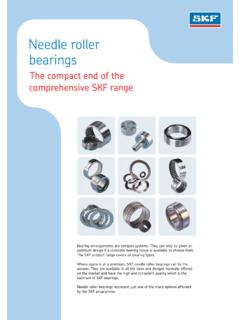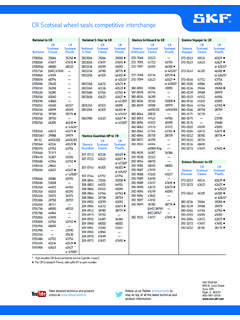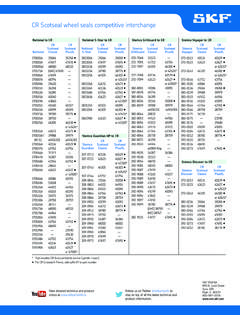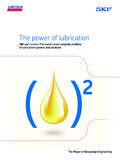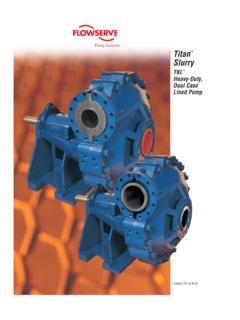Transcription of Spectrum Analysis - SKF
1 Spectrum AnalysisThe key features of analyzing spectraBy Jason Mais SKF USA guide introduces machinery maintenance workers to condition monitoring Analysis methods used to detect and analyze machine com-ponent failures. It informs the reader about common Analysis methods . It intends to lay the foundation for understanding machinery Analysis concepts and show the reader what is needed to perform an actual Analysis on specific Introduction .. 32. Common steps in a vibration monitoring program .. 43. Step 1 .. Collect useful information .. Identify components of the machine that could cause vibration.
2 Identify the running speed .. Other key considerations .. Identify the type of measurement that produced the FFT Spectrum .. 54. Step 2 .. Analyze Spectrum .. Common components of vibration spectrums .. Identify and verify suspected fault frequencies .. Determine fault severity .. 65. Misalignment .. 76. Unbalance .. 117. Mechanical looseness .. 148. Bent shaft .. 159. Rolling element bearing defects .. 1610. Gears .. 2311. Blades and vanes.. 2512. Electrical problems .. 2713. Step 3 .. Multi-parameter monitoring.
3 2814. Conclusions .. 2915. Further reading .. 29 Contents21. IntroductionA vibration FFT (Fast Fourier Transform) Spectrum is an incredibly useful tool for machinery vibration Analysis . If a machinery problem exists, FFT spectra provide information to help determine the source and cause of the problem and, with trending, how long until the problem becomes spectra allow us to analyze vibration amplitudes at various component frequencies on the FFT Spectrum . In this way, we can identify and track vibration occurring at specific frequencies. Since we know that particular machinery problems generate vibration at specific fre-quencies, we can use this information to diagnose the cause of excessive key focus of this article hinges on the proper techniques regarding data collection and common types of problems diagnosable with vibration Analysis techniques.
4 This article can be used as a reference source when diagnosing vibration 1. Example of a velocity Spectrum that contains running speed (at F = 2 700 RPM or 45 Hz), harmonics of running speed (at F = 4 500 RPM or 75 Hz) and bearing defect frequencies (at F = ~31 000 RPM (516 Hz) and ~39 000 RPM (650Hz) marked with bearing overlay markers).32. Common steps in a vibration monitoring programThere are several steps to follow as guidelines to help achieve a successful vibration monitoring program. The following is a g eneral list of these steps:Collect useful information Look, listen and feel the machinery to check for resonance.
5 Identify what measurements are needed (point and 1 point type). Conduct additional testing if further data is spectral data Evaluate the overall values and specific frequencies corresponding to machinery anomalies. Compare overall values 2 in different directions and current measurements with historical monitoring Use additional techniques to conclude the fault type. ( Analysis tools such as phase measurements, current 3 Analysis , acceleration enveloping, oil Analysis and thermography can be used.)Perform Root Cause Analysis (RCA) In order to identify the real causes of the problem and to prevent it from occurring Reporting and planning actions Use a Computer Maintenance Management System (CMMS) to rectify the problem and take action to 5 achieve a this article, only steps 1 through 3 are investigated.
6 The reader is referred to other SKF @ptitudeXchange articles on RCA and CMMS to explain these additional monitoring Step Collect useful informationWhen conducting a vibration program, certain preliminary information is needed in order to conduct an Analysis . The identification of components, running speed, operating environment and types of measurements should be determined initially to assess the overall Identify components of the machine that could cause vibrationBefore a Spectrum can be analyzed, the components that cause vibration within the machine must be identified.
7 For example, you should be familiar with these key components:If the machine is connected to a fan or pump, it is important to know the number of fan blades or impellers. If bearings are present, know the bearing identification number or its designation. If the machine contains, or is coupled, to a gearbox, know the number of teeth and shaft speeds. If the machine is driven with belts, know the belt lengths. The above information helps assess Spectrum components and helps identify the vibration source. Determining the running speed is the initial task. There are several methods to help identify this Identify the running speedKnowing the machine s running speed is critical when analyzing an FFT Spectrum .
8 Running speed is related to most components within the machine and therefore, aids in assessing overall machine health. There are several ways to determine running speed:Read the speed from instrumentation at the machine or from instrumentation in the control room monitoring the machine. Look for peaks in the Spectrum at 1 800 or 3 600 RPM (1 500 and 3 000 RPM for 50 Hz countries) if the machine is an induction electric motor, as electric motors usually run at these speeds. If the machine is variable speed, look for peaks in the Spectrum that are close to the running speed of the machine during the time at which the data is FFT s running speed peak is typically the first significant peak in the Spectrum when reading the Spectrum from left to ri ght.
9 Look for this peak and check for peaks at two times, three times, four times, etc. Multiples of the running speed frequency can be an indication of machine Other key considerationsThere are many other considerations to take into account when analyzing a machine. For example:If the machine operates in the same vicinity as another machine, it is important to know the running speed of the adjacent machine. Occasionally, vibration from one machine can travel through the foundation or structure and affect vibration levels on an adjacent if the machine is mounted horizontally or vertically.
10 Mounting orientation affects machine response to vibration. Know if the machine is overhung or connected to anything that is overhung. Machine support can affect the response of the vibration Identify the type of measurement that produced the FFT spectrumVibration monitoring programs use many types of measurements to determine the condition of machinery. It is important to determine which type of measurement displays the the measurement displacement, velocity, acceleration, acceleration enveloping, Depending upon the information needed, a particular measurement should be tailored to capture the proper was the sensor positioned: horizontal, vertical, axial, in the load zone, Sensor response varies depending upon mounting previously recorded values, FFTs or overall trend plots available?



